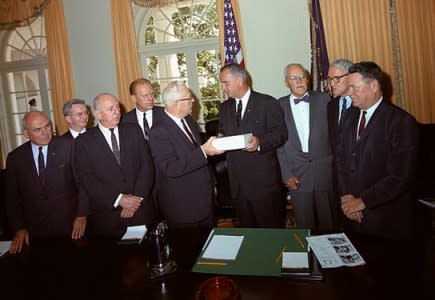Inside the Warren Commission and the JFK assassination
For the past 50 years, the Warren Commission’s role in the John F. Kennedy assassination case has been the subject of intense debate. On the assassination’s eve, author Phillip Shenon reveals new details about the investigation.
Shenon appeared at the National Constitution Center to discuss his new book, “A Cruel and Shocking Act: The Secret History of the Kennedy Assassination.”
Shenon said the road to his detailed record of the commission’s work started with a phone call in 2008 from a distinguished attorney who had been on the Warren Commission, and he wanted to tell the story about the young lawyers who did the basic investigation.
His source led him to other former members, and a detailed look inside the commission’s work and the problems it ran into gathering evidence.
“For most of the past 50 years the Warren Commission has been the subject of harsh criticism and ridicule, and most Americans don’t believe the Warren Commission,” he said.
“He wanted to get on to the record that he and his colleagues, the young staffers, did a good job, they did best that they could,” Shenon said. “And they have all been disappointed to discover how much evidence was withheld from them.”
Shenon believes the commission’s work was rushed and the “gaps” allowed conspiracy theories to blossom.
He also believes evidence that would have linked accused assassin Lee Harvey Oswald to a Cuban connection was deliberately hidden from commission investigators.
In particular, Oswald’s trip to Mexico City for a possible meeting with people with connections to Cuba was hidden from Warren Commission staffers, says Shenon.
Shenon says the CIA had knowledge that Oswald was meeting with pro-Castro people while in Mexico, possibly in an attempt to defect to Cuba, since the agency had Oswald under surveillance.
He also points to James Jesus Angleton, a chief CIA operative, who intervened to limit the amount of CIA information given to the Warren Commission, including alleged attempts by the CIA to kill Castro.
Shenon also says the U.S. ambassador to Mexico, Thomas Mann, told investigators in secret testimony that he was asked by Secretary of State Dean Rusk to “shut down” any investigation into a Castro connection to Kennedy’s death.
“He was astonished by that,” Shenon said, and the testimony showed that Mann believed the order came because of the CIA’s connection to plots about Castro.
Another topic that Shenon talks about is how the Warren Commission came up with the single-bullet theory. He says the commission didn’t buy the original theory proposed by the FBI that three bullets hit Kennedy’s car once it saw the Zapruder film.
Arlen Specter and others then believed that one bullet struck Kennedy and then hit Governor John Connally, once it saw the time that the assassin had to fire three shots.
Recent Historical Stories
10 interesting websites about the Kennedy assassination
JFK’s warnings about television, money and politics ring true today
The drama behind President Kennedy’s 1960 election win
10 fascinating facts about President John F. Kennedy
“The staff could determine by watching the film pretty quickly that Oswald didn’t have time to get off three shots,” he says.
It was a Navy pathologist, along with Specter, who determined that one bullet went through two men.
Shenon also said the Warren Commission was shocked by the behavior of the local police and Secret Service agents, who seemed distracted during the motorcade.
But to Shenon, the CIA remains at the center of the Warren Commission controversy.
“The arrogance of the leadership of the CIA at that time is just extraordinary,” Shenon said. “The decision was made at the CIA that they would be fully cooperative with the Warren Commission on anything the Warren Commission asked for. But they would volunteer nothing, including the fact that they had been trying to kill a key suspect in the Kennedy assassination investigation, Fidel Castro.”
Another piece of evidence cited by Shenon is a cable written by FBI Director J. Edgar Hoover to the Warren Commission, which cited a report from a reliable source in Mexico that Oswald had walked into the Cuban embassy in Mexico City in September 1963 and announced he was going to kill President Kennedy.
Shenon said for some reason, the memo wasn’t given to Warren Commission investigators.
And there was an instance when the commission arranged for a possible key witness in Mexico to come to the United States to testify, but the commission head Chief Justice Earl Warren refused to allow the interview.
The commission did allow one member to meet with Castro off the coast of Cuba for a three-hour interview, where he denied any involvement in the assassination.


